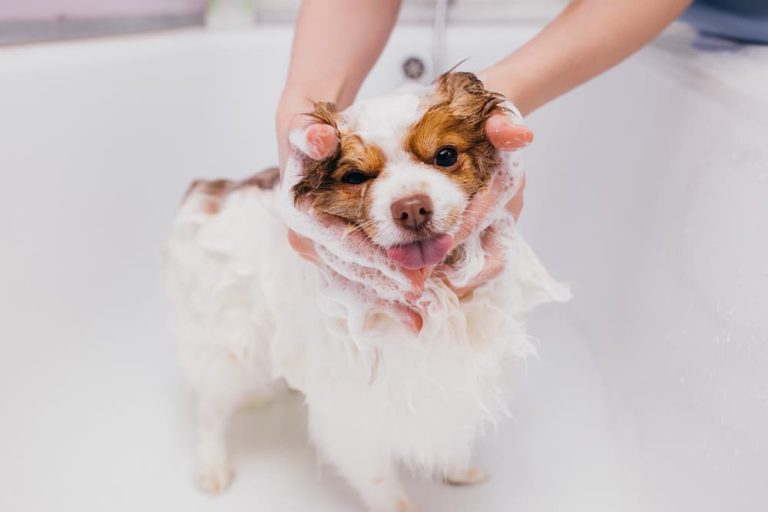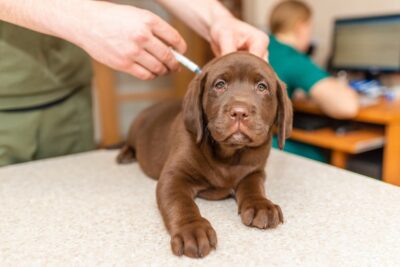How to Bathe a Puppy: Tips, Schedule, and Grooming Essentials

You’ve got a new puppy, and no matter the breed, coat type or grooming requirements, it’s a safe bet that you’re eventually going to need to bathe your best friend. But learning how to bathe a puppy can be a challenging process.
Lathering up can be stressful for puppies if the right steps aren’t taken. That’s why it helps to initiate a slow and steady puppy grooming process.
By giving your puppy time to acclimate to bathing at a young age, you can ensure a lifetime of safe, comfortable baths and grooming sessions. In this article, we’ll discuss how to begin the process with your new pup.
Puppy Bath Basics
Let’s face it, taking a bath can seem pretty overwhelming to a young puppy. Between the novel location, noise, sensation of the water, unfamiliar scents, and strange body handling, bath time can be downright scary! That’s why the initial parts of training are so critical. Like most things when it comes to training a new puppy, getting ready for a bath takes preparation and patience.
So, when can puppies have their first bath? The old advice was to wait to bathe a puppy until 6 months of age. However, waiting that long can result in a number of problems, from the physical – like difficult-to-clean matted fur – to the developmental, where the puppy is so scared that bathing becomes a messy nightmare.
You can avoid these issues by beginning basic training within the first few weeks of bringing your puppy home, then attempting a real bath once your puppy seems confident with all of the steps. Starting off tub time with short and sweet training sessions will help both you and your new pup learn to enjoy the scrubbing process.
Things to Consider Before Bathing a Puppy

Remember that everything about bathing a puppy is a brand new experience for your dog. Before you turn on the tap and get to washing, it’s important to introduce all of the parts of the process first.
Take your time familiarizing your puppy with bath time routines and essentials before you try your first puppy bath:
- Give your puppy a chance to explore the bathing area, whether it’s a dog bath tub or the kitchen sink. Make it a positive experience by giving your pup treats while she checks it out, or better yet, spread peanut butter on the porcelain for your pup to enjoy. The goal is to establish a positive association to the space.
- Allow your pup to see and sniff the products and tools you’ll be using, like puppy shampoo and brushes.
- Get your pup used to the sound of the water by turning it on low while she’s nearby but not in the tub or sink. Give her treats as the water flows, then stop giving them when you turn the water off.
- Once your puppy is comfortable in the bathing area, begin to mimic the sort of handling you’ll do during a bath. Give small treats, then handle each area of your puppy, like gently rubbing her fur, picking up her paws, covering her ears and eyes as you’ll do when rinsing, and massaging her tail and rump. Don’t forget to give her lots of praise!
- Finally, help your dog feel comfortable with post-bath toweling off and brushing by rubbing the towel along your dog’s back then giving a treat several times in a row.
The goal of this preparation is to give your puppy a positive association to every step of bath time.
How to Bathe a Puppy: What You’ll Need
There’s more to giving a puppy a bath than just puppy shampoo. (Though that is on our list of must-haves!) To make the most of your tub time you’ll need the following puppy essentials:
- A high-quality shampoo and conditioner. It’s best to not penny pinch on bathing products because low-cost puppy shampoos often contain potentially harmful ingredients. Look for USA sourced and made products with minimal additives and chemicals. Avoid shampoos with complicated ingredient lists, or vague descriptors like “fragrance,” but keep in mind that some scary-sounding names are actually dog-safe preservatives that prevent mold growth.
- The right location. Petite pups might be more comfortable in a smaller dog bath tub, like the kitchen or laundry room sink. Bathing a new puppy outside with a hose isn’t a good idea since you can’t regulate the water temperature. It’s easiest to bathe using a hand shower attachment, but if that’s not an option, use a plastic container for rinsing.
- Towels. You’ll need plenty of them! Tubs and sinks get slippery, so consider placing one on the bottom that your pup can stand on, as well as one to step on for the big post-bath shake off. And of course you’ll need one for drying off afterwards too.
- A brush or comb. Long-haired pups will need to be brushed out after a bath, so select the right type of bristles for your dog’s fur.
Step by Step: How to Bathe a Puppy

Okay, now that you’ve done all of your pre-bath prep, you and your pup are ready for the main event: puppy’s first bath!
- Before you begin, grab some peanut butter and a handful of treats so you can reward your pup for her bravery, along with the rest of your supplies.
- Spread some peanut butter on the wall as you turn the water on low and check the temperature. It should be warm to the touch but not hot. Place your pup in the tub when the temperature feels comfortable.
- Direct a gentle stream of water to your pup’s paws first and give treats (or let her lick the peanut butter), then slowly bring the nozzle up to dampen the rest of your puppy’s body. If your pup is nervous about the sound of the water, try gently pressing the nozzle to her body with the water very low.
- Once your puppy’s body is thoroughly wet, dilute the shampoo according to the directions on the bottle and begin to gently lather, starting along your dog’s spine and working your way down.
- Use a washcloth to wash your pup’s face, making sure to avoid the eyes and ears. When rinsing, cover your dog’s eyes with your palm, and then gently cover the ears to prevent water from getting inside.
- After rinsing (and keep in mind that it might take several rinses to get all of the soap out), place the suggested amount of conditioner on your pup’s coat, give her more peanut butter or treats during the conditioning period, then rinse thoroughly.
- Once your pup is fully rinsed, help her out of the tub, allow her to shake off, and then towel her off until dry.
Puppy Bathing FAQs

When can you bathe a puppy?
Moving into a new home can be stressful, so it’s best to give puppies time to get used to their environment before attempting the first bath. Most puppies can have their first bath between 8-12 weeks of age. However, it’s fine to begin the introductory steps right away.
How often should I bathe my puppy?
How often to bathe a puppy depends on factors like your puppy’s lifestyle and coat type. Active outdoor pups will likely need more frequent bathing.
Can you take a puppy to the groomer?
Some canine coat types require grooming, like Poodles and Bichons, so it’s a good idea to help your puppy understand that the salon is a fun place to visit. Schedule an introductory appointment before your pup actually requires grooming so that your groomer can set your puppy up for a lifetime of happy, stress-free visits.
What should pet parents do about matted fur?
Matted fur is more than just a cosmetic issue. Mats can cause serious health problems, from restricted movement to pain, so treating them, or better yet, preventing them, is important for your dog’s wellbeing. Dogs with longer fur should be brushed daily to prevent matting, and clothing like sweaters and jackets should be removed regularly to prevent mats from forming.









